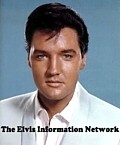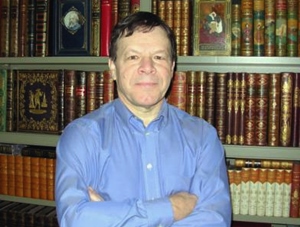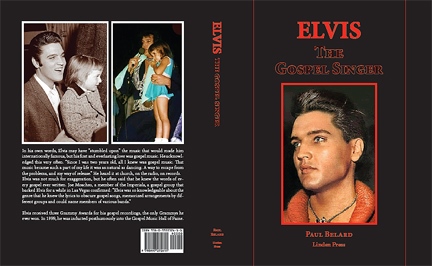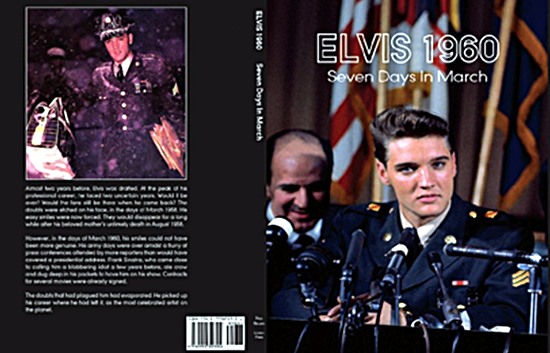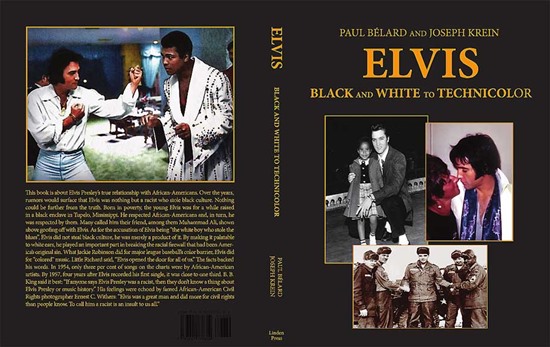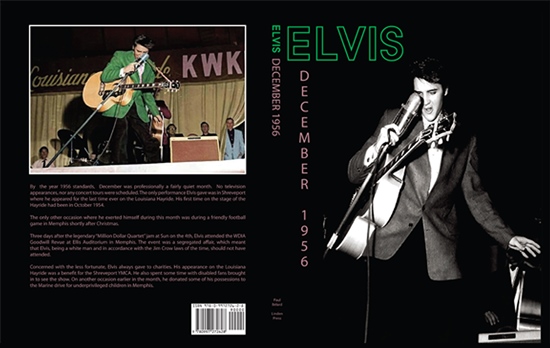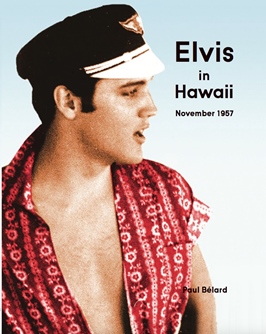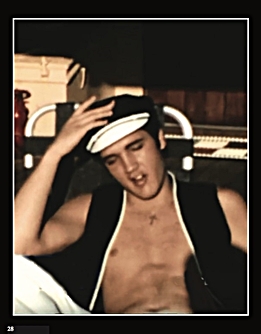 |
 |

Interview EIN: Who is Paul Belard? PB: I was born on a farm in the center of France. My parents moved near Paris when I was four. I studied engineering and after a stint in the Armée de l’Air (the French Air Force), I started my career at Michelin Tire Corporation. There, I met my future wife. An American, she was working at the time for the same company. She came to France on a business trip. Following a two year trans-Atlantic courtship, we were married in New York and I made the US my new home. I worked for a giant telecommunications company as a project engineer and retired 10 years ago. I have written several books, four of them published in France. A lover of books, I learned how to bind them and restore them as a hobby. I teach kids to do it in a nearby school and give talks on the subject at several local universities. Anyone interested can check my site at www.newyorkbookrepair.com. EIN: When did you become an Elvis fan and how did it develop into you becoming an Elvis book publisher? PB: I think I heard Elvis as early as 1958 on the radio. My first record was the French EP Rock’N’Roll No2 with “ Shake, Rattle And Roll”, “Blue Suede Shoes”, “Blue Moon”, “Tutti Frutti”. My friends and I were at first astonished; we did not know whether the singer was black or white; we did not understand a word he sang, his voice was just another instrument. He was so damn good. Money was tight, so we used to meet at the local record store and ask the lady to play him for us. She was kind to play them for free. My second purchase was Le Retour d’Elvis (Elvis is Back) LP. Since then, I have been a fan through thin and thick. EIN: Paul, you have now released four books about Elvis. You have a particular objective with your books. Please tell us about that.
So my aim is to publish a series of books covering his entire career. To be honest, I do not intend to be as thorough during the years 1964 to 68 (before the magical comeback) or his latest years. Still it will be an extensive collection of books. July 1954 to 1962 are 90 percent complete. It will be about 50 books just for this span of time. EIN: Paul, that is a staggering number of books! When you publish these you will become the world's most prolific Elvis publisher. EIN: You recently released two new Elvis books, Elvis Black and White to Technicolor and Elvis 1960 Seven Days In March. Please tell us about them? PB: Regarding the first, I decided to write it because I was getting tired of hearing from ignorant people that Elvis was a racist and stole black music. The aim of this book is to expose the vacuity of these statements using first-person accounts of African-Americans who had known Elvis for a long time or who met him for only a few minutes. They include singers, actors, preachers, friends and members of the general public. Mississippi and Tennessee of 1956 where Elvis was born and raised, topped the list of the most racist states in the United States. Memphis was still a heavily segregated city where white people did not associate with African-Americans. There is a picture in the book showing the zoo closed to white people because only the African-Americans were allowed to visit that day. Despite this environment, Elvis never hid his love of black music and the respect he had for “colored” people. He never shied away from shaking their hands or putting his arm around their shoulders, even at the risk of being labeled a “Negro-lover”. This did not go unnoticed by the black community. In the summer of 1956, two African-American newspapers in Memphis hailed Elvis as a “Race Man”, not just for his music but also for his indifference to ingrained racial distinctions. In the summer of 1956, The Memphis World reported: “The rock ’n’ roll phenomenon cracked Memphis’s segregation laws by attending the Memphis Fairgrounds amusement park during what is designated as colored night.” Going to such an event took courage, for it was against the laws in effect at that time. This was not the action of a racist in a town rampant with ethnic prejudice. Indeed it was just the opposite. In Tupelo, Elvis’ family was one of two living in a black ghetto. You do not steal what you’ve been raised with . There is no doubt that Elvis was always closer to black culture than he was to the white one. The African-American community owes Elvis a huge debt. In 1954, only three percent of the songs on the main charts were by African-American artists. By 1957, four years after Elvis recorder his first single, it had jumped to one third. As BB King said: "If anyone says Elvis Presley was a racist, then they don’t know a thing about Elvis Presley or music history." So it is a shame that a dubious article in an obscure magazine made such an impact. But this is the price of fame.
For Elvis 1960 Seven Days In March, I wanted to retrace those glorious seven days that brought Elvis back to the US. So many pictures were taken, which one to select became a problem. Had I used them all, the book would have been three times as thick. The ones used cover his departure from the house he rented, stepping on the plane that would bring him back, the stops in Scotland and Newfoundland, Canada. His arrival in the States, highlighted with the famous press conference worthy of a head of state. Then there are a few pictures of his last Army days, a rare picture of him stuck in the snow on his way to Washington to catch the train that would take him to Memphis. It ends with his triumphal arrival in his home town. EIN: Elvis Black and White to Technicolor, is co-produced with Joseph Krein. How did your collaboration with Joe come about? PB: Joe is the host of the radio show http://www.elvis-express.com with Lee Dawson. One can listen to it on the internet every Saturday afternoon. Joe lives in New York State and we became friends. He provided a few pictures and a lengthy interview with Jerome “Stump” Monroe, the Sweet Inspiration’s drummer, who replaced Ronnie Tutt when he was unable to play. EIN: There are a number of historically very important inclusions in Elvis Black and White to Technicolor including a reproduction of the August 1957 article in the magazine, Jet, rebutting claims that Elvis was racist. Were you able to source the earlier article from April 1957 in another Black American magazine, Sepia, which largely started the ‘Elvis is racist’ story? PB: When I researched the book, I could not locate this magazine. Recently however, I came across an interview by Professor Michael Bertrand , a respected Elvis scholar, where pages relating to the article of this particular magazine are shown. One can see it on https://www.youtube.com/watch?v=hzZ0e9mlsIc.
EIN: What made you decide to self-publish (and how difficult have you found the process)? PB: I toyed with the idea of going through a publisher for Elvis Black and White… To publish in the US, you need an agent. I did not and did not feel like looking for one. Also, no company would be interested in publishing so many books about one individual, be they as successful as Elvis. It is not my intent to make money on these books. I am interested in the research, in writing them, not so much in spending a lot of time promoting them. That is why each book is limited to 50 signed copies. If you self-publish, you are in control. I choose the titles, the covers, the number of pages. Self-publishing is tightly wed to print-in-demand. I can have the books printed as orders come in, not having to store large quantities in the garage. The big difficulty was getting used to the design software. I use InDesign and it is not user friendly. It is also expensive. But I have it under control now. I had to acquire PhotoShop and learn how to use it to handle the pictures. I even learned how to colorize pictures. The picture on the cover of the book Hawaii 1957 has been colorized and it came out great. So, yes, you are in control, but it means you are on your own. You have to figure out the lay-out of the pages, write whatever is necessary, do the research, and review the internet, the Elvis websites, EIN, FECC, Elvis Express Radio to name just a few. It is time consuming but you cannot believe how many rare pictures I found on obscure sites in Russia, Turkey or wherever. When you have the draft, you need to upload the cover and the inside to the printer’s site. You need to answer his inevitable questions. Then you get a proof and you need to check it and upload it again. It is a long process. All these steps cost money. EIN: The easy to use and cost effective availability of self-publishing and print-on-demand options for producing books (including Amazon’s CreateSpace Independent Publishing Platform, Blurb and BookSurge Publishing) appears to be a two-edged sword. On the one hand it allows anyone to publish a book, but on the other hand, particularly in relation to Elvis, it means fans are often spoilt for choice, and the proliferation of titles makes it more difficult for authors to find a wide market unless they have a solid marketing strategy. Do you agree? PB: Yes, of course. In my case, with dozens of books on the verge of being done, I need to pace the release. But, as I said, it is not for the money. I sell them at cost. The most expensive book I wrote has more than 300 pages, hundreds of B&W and color pictures and it is only $50. It is unheard of in the Elvis book market. The shipping costs out of the US, can be sometimes as high as 2/3 of the price of the book itself. It is a big obstacle for selling the books abroad. I do not produce in enough quantities to get a discount from shipping companies. Publishing books exposes you to a lot of comments, good and bad. One fan said of one of them that it was a just a money making scheme. Another wrote that it was the worst book on Elvis he had ever seen, obviously not written by a fan; interestingly enough, it was his second comment, the first when he got it was: great book. Go figure! Anyway, I’m pleased with the praise; I accept and implement constructive criticism and, thankfully, the nasty comments slip off my back like water drops on duck feathers.
EIN: The Elvis book market is also quite crowded these days with Follow That Dream Records, KJ Consulting (The Elvis Files), JAT Productions, MRS, Venus Productions and others producing regular and high quality releases not to mention the growing number of “self-published” titles and mainstream releases from major publishers. In this context, differentiation can be an important factor. How do your books differentiate themselves from other releases? PB: Besides looking for pictures, I put each of them in its context. In Elvis The Searcher, too many pictures do not match what is shown on the screen. It is annoying. That is why every picture is dated, properly sequenced, and noted with its right location. Naturally, I do not know everything; but I’m lucky to have experts to check the accuracy of my books. That is why I owe a great debt of gratitude to two FECC members, Dr. John Carpenter, M.D. and Mike Koppenaal, as well as Paul E. Peters from Phoenix, The Elvis Forum. Joe Krein also helps. Does it means there won’t be any errors? Of course not, but at least, we’re trying to minimize them. Anyway, sometimes you can follow Elvis hour by hour. It is fascinating. EIN: Elvis photo books/photo-journals have long been a popular sub-genre in the vast Elvis library. What is it about the sub-genre that makes it so enduring? PB: Once again, it is Elvis himself. He was so good looking, so cool, so polite off stage and so wild on stage, so talented. I can listen to “Lawdy Miss Clawdy”, “Trying To Get To You”, “Starting Today” just to name a few and still get the same feeling of wonder I got the first time I heard them. They are timeless. Looking at his pictures when he was young, and even later in his career, is learning to find out what drove him. And there’s that dazzling smile, that self-confidence. Short of having been able to talk to him, these are the only documents that really give an insight into who he really was. You can’t change the expression on a picture. If I may expand on the subject, I think the revamped records help to keep him in the limelight and bring new generations of fans. The techno “A Little Less Conversation” was a huge hit worldwide, so was the first CD with the Royal Philharmonic Orchestra. I know some purists balk at the idea. Why? It’s not as if somebody painted over the Mona Lisa for God’s sake, the originals are still available. RCA itself tampered with Elvis music, releasing numerous records from spliced takes; Chet Atkins provided a new background to “Tomorrow Night”, so where’s the problem? I think the new CD Where No One Stands Alone is great. Are all the new songs better than the originals? No, but it’s nice to hear different versions and I’m sure these releases attract new fans. EIN: Paul, as you mention, your books are principally photo based but they also include an array of historic material, press clippings, interviews, articles, etc., which add value to your releases. Is it a case of letting the images tell the story? PB: Yes, I want you to follow Elvis day by day, sometimes hour by hour. There are so many pictures taken of the man that, in some cases, there are photos for every day of a month. These books are historical documents, a scholarly study of Elvis’ career. Contemporary articles add to the sense of being there. I rarely comment, unless there is an error in an article.
EIN: In one of your earlier books, Elvis Las Vegas April – May 1956, you have many great photos of Elvis live on stage, off stage with fans and Elvis relaxing. Quite a few of these I don’t recall having seen before. And in Elvis in Hawaii November 1957 you feature a press article, Teen-agers Will See but Not Touch Elvis from the Honolulu Star-Bulletin. The article included a fascinating hand drawing showing how Elvis was going to be protected from fans while staying at the Hawaiian Village Hotel – this is a neat and unusual piece of Elvis history. How do you source the photographs and historic material for your books? PB: By “source”, do you mean where I found them or who is the originator of the document? If the person who took the picture is known, he is mentioned under the picture. Very often, no name is associated with the pic. It is not surprising. When you look at the press conferences Elvis gave when he left the Army, as well as the stops he made during the return trip, there are dozens of photographers. Life Magazine may have identified the pictures taken by its reporters, but it is the exception. Hundreds of pictures are unidentified. EIN: What have been some of your favorite discoveries when sourcing photos and other materials for your Elvis books? PB: First and foremost, pictures I had never seen. It was a thrill each time I found one, even if the quality was not perfect. If it is of historic value, I put a less than clear picture in the book. Secondly, on the internet, there are quite a few interviews of fans that were present at these early concerts. Now in their sixties or seventies, they still recall clearly what happened and reading their recollections is moving, and often of historical value. EIN: In preparing your seven books what have learned about Elvis that you didn’t already know? PB: Well, first, I was surprised by the amount of work Elvis, Scotty and Bill put out once his first single was released. It was a grueling slog almost every night for almost two years, driving thousands of miles, sleeping God knows where. Secondly, I’m going to be frank. It obviously brought into the open how Elvis was exploited by his manager and how it hurt his career and standing as the most gifted artist there ever was and is. Let’s just look at the impact of Parker creating his own pool of song writers just for the sake of making more money. Listen to “Reconsider Baby” next to “Yoga Is As Yoga Does”. Can one do it without feeling a deep sense of loss, and extreme outrage even, at the wasted talent? I can’t and I still to this day seethe just thinking about what could have been. From the very beginning, Parker showed he did not understand Elvis. Why would he have booked him for two weeks in Las Vegas in early 1956 to perform in front of an audience of middle aged or retired people? Were they the ones who bought “Heartbreak Hotel”? Of course not. Recently, I saw the form that he had Elvis sign stating that he co-wrote some songs for Love Me Tender. Elvis confirmed that he never wrote a word. This was pure and simple theft. A book could be written about the wickedness of this control freak. Some will say: Well, he put Elvis on TV. Nonsense! Any promoter worth his salt would have done the same. It was the medium that gave the most exposure and the companies that were bidding on Elvis’ Sun contract would have done the same. Once Elvis appeared on the Dorsey Shows, he was unstoppable. It is not Parker that made Ed Sullivan change his mind about having Elvis on his show, it was Elvis’ talent and impact on the public. Elvis became Parker’s personal ATM. Conversely, it made me wonder about Elvis. Did he really understand his power? He could have torn up Easy come, Easy Go’s script, to name just one, and ask for a better one; he could have rejected all the songs and the studios would have bowed to all his wishes. He did not like conflict and it hurt his acting and singing career. Anyway, it’s too late to dwell on “what might have been”. We are just fortunate Elvis gave us so many great songs. The fact that there could have been so many more is just a tragedy.
|
|
